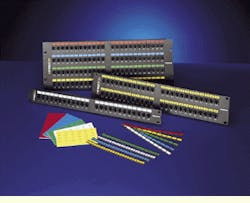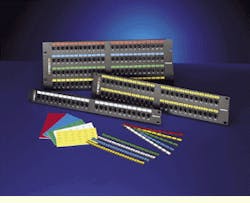Barbara E. Thompson
Installers use patch panels in the telecommunications closet to terminate cables and make the terminations available for interconnection to other cables. These devices allow end users to adapt cabling systems for growth and change. As components in a Category 5 system, patch panels must meet the requirements in the Electronic Industries Association/Telecommunications Industry Association-568 wiring standards for connecting hardware and cable.
Typical patch panels provide registered jack (RJ-45 type) connection to the premises equipment. The horizontal wiring is brought to the back of the panel, where it is often punched down in an insulation displacement connection-type connection. Modular patch panels typically use a printed-circuit board as the interconnection method that, according to manufacturers, provides the low insertion-loss and crosstalk characteristics required for 100-megabit-per-second local area networks.
On the back of the panel, "it is important to maintain the cable twist, right up to the point of termination," says Brian Reed, product manager at Mod-Tap (Harvard, MA). To maintain the integrity of the Category 5 system, "you need to be careful not to strip too much of the outer jacket. Bend radius is another area of concern: The current bend radius is recommended at three times the cable diameter. If it`s more, it can affect the properties of the cable, particularly in high-density panels where the pairs are close together," he explains.
Manufacturers offer patch panels in standard and high-density models, with 12- to 120-port configurations. The standard model gives the installer more space between ports than the high-density version.
"Density is not that big an issue unless it`s a very large project," says Sam Flaherty, president at Teledata Systems Corp. (Souderton, PA). "For example, we just bid on a job where the customer has 500 workstations. At the job site, there were 96-port patch panels approximately 1.5 feet each; with six panels, that`s nine feet of rack space. At this site, it`s also Category 3, so we`re going to redo it, using Category 5 and 48-port patch panels that are 5.25 inches or less to reduce the amount of rack space."
Sam Parthemer, project manager at Datalink Solutions Inc. (San Diego, CA), says his company also leans toward two 48s versus one 96-port configuration. "Not so much because of the density problem in the rear. Because with that many rows, it can get to be a little tight as far as terminations go," he says. "The problem is that the customer requests better wire management on the front of the panel. By breaking it up, we can do that."
The number of ports, as well as the type of wiring termination, is important when you are choosing your patch panel. Many manufacturers now offer modular patch panels. "These are just like modular faceplates: You can plug in a wide variety of jacks and connectors, such as T568A or B, RJ-11s, and even fiber or coaxial connectors," says David Yanish, product manager at Krone Inc. (Englewood, CO).
Most panels can be mounted in a standard 19-inch equipment rack or wall-mounted. However, a few manufacturers make a mini patch panel that is bracket-mounted to fit the 66-block footprint.
Cable management
Some patch panels ship with cable management, and most manufacturers offer it as an option to keep cables orderly. "Cable management is critical to maintain bend radius," says Tony Siderewicz, director of market and product development at Ortronics (Pawcatuck, CT). "At the same time, it lets the installer keep the cable jacket as close as possible to the point of termination."
Manufacturers also provide labeling slots to identify the patch panel and each port so that installers can comply with the EIA/TIA-606 administration standard for labeling.
"We look for a panel that has not only a port number," says Flaherty, "but also space where you can write your own information." And Parthemer explains they use a label maker to relabel the patch panel. "When you have two 48-port panels, instead of having port numbers 1-48 panel A and 1-48 panel B, we go ahead and relabel them 1-96 or whatever the customer system is."
"Once you`ve identified a manufacturer that offers certified Category 5 patch panels that have the appropriate density and provide space to write your own information," says Flaherty, "95% of the people out there can meet these three criteria. Then it becomes an issue of who has the best price."
In the telecommunications closet, you can identify 24-, 48- and 72-port Category 5 patch panels with color-coded designation strips.

